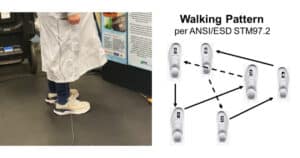This article is the second and final part of Static Control Resilient Flooring Qualification Procedures Ensure Space and Defense ESD Compliance. Read Part 1 here. ANSI/ESD STM97.2 This critical standard test method attests to the static control resilient flooring’s ability to minimize charge buildup and provides the user with traceable data to assign a voltage flooring … [Read more...]
Static Control Resilient Flooring Qualification Procedures Ensure Space and Defense ESD Compliance Pt. 1
Due to the rapid densification of ESD sensitive devices (ESDS), static control resilient flooring (ESD flooring) has found its way into FAA towers, operating room theatres, MRI/CT scan flooring areas, aircraft terminals, IT data centers, Navy ships, space & defense flight lines, call centers, medical device manufacturing, pharmaceutical delivery and the … [Read more...]
Risk Mitigation: Advanced ESD Instrumentation for Qualification Testing of Static Shielding Bags
Today, Suspect Counterfeit ESD Control and Non-Compliant Packaging is a growing issue throughout the Global Supply Chain. EEE parts (ESD sensitive devices) damage transcends circuit cards, touch screen displays, handheld devices, and other microprocessor driven products. Suspect counterfeit static control or non-compliant electrostatic discharge (ESD) shielding bags can be … [Read more...]
Personal Protective Equipment (PPE) Evaluation Methods of Static Control Gloves for ESD Integrity
Static Control gloves can be classified as Personal Protective Equipment (PPE) to reduce the risk of electrostatic discharge (ESD). There are several types of ESD Gloves: Nitrile, Vinyl, Latex, Rubber and humidity independent conductive carbon/nylon yarn gloves as illustrated in Figure 1 above. Due to an astounding rise in the number of non-compliant and suspect … [Read more...]
Why ANSI/ESD S20.20 1-Foot Rule for Charge Generators needs to be Increased to 1-Meter for Aerospace & Defense
INTRODUCTION IN THE SEMICONDUCTOR SECTOR TODAY, ESD sensitive devices can be damaged at <+/-50 volts. Aerospace & Defense cannot issue a Return Materials Authorization (RMA) for an ESD sensitive device that fails in space or a nonfunctioning weapon system in-theatre. The fact that extruded film can charge up to over +/- 100,000 volts below 20% RHhas been … [Read more...]










